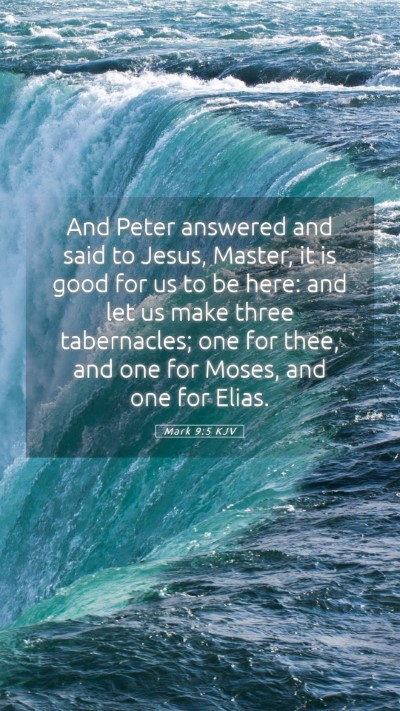Understanding Mark 9:5
Mark 9:5 states, "And Peter answered and said to Jesus, ‘Rabbi, it is good for us to be here; and let us make three tabernacles; one for You, one for Moses, and one for Elijah’". This verse occurs during the account of the Transfiguration of Jesus, a significant moment that reveals His divine glory and establishes His relationship with the law and the prophets.
Bible Verse Meanings
This verse captures Peter’s reaction upon witnessing the Transfiguration, in which Jesus appears alongside Moses and Elijah. The suggestion to build tabernacles indicates Peter’s desire to prolong the moment of divine revelation. Through various commentaries, we can glean a deeper understanding of this passage.
Bible Verse Interpretations
-
Matthew Henry's Commentary:
Henry emphasizes that Peter’s proposal comes from a place of awe and reverence. He recognizes the importance of the moment but fails to grasp the full significance of Jesus’ identity. His desire to build shelters reflects an Old Testament practice of commemorating significant events.
-
Albert Barnes' Notes:
Barnes points out that Peter's suggestion stems from the glory revealed to him. However, he misinterprets the purpose of the experience. The tabernacles signify a desire to stay in the moment rather than understanding the greater mission ahead for Jesus. This highlights a common human tendency to cling to spiritual highs rather than follow Christ into suffering and service.
-
Adam Clarke's Commentary:
Clarke elaborates on the Jewish tradition of building tabernacles during the Feast of Booths. He notes that Peter's proposal can be seen as an inclination to worship and honor the figures present, yet it also shows a misunderstanding of the significance of Jesus as the fulfillment of the law and the prophets.
Bible Verse Explanations
In light of the commentaries, we can derive several conclusions from Mark 9:5. The text illustrates Peter’s human impulse to memorialize divine encounters. It reflects our tendency to wish to capture and hold onto spiritual experiences instead of recognizing their purpose within the broader narrative of faith.
Scripture Analysis
Analyzing this scripture, it is essential to consider the context of the Transfiguration event. The appearance of Moses and Elijah represents the law and the prophets, respectively. Peter’s request to build three tabernacles suggests an equality among the three figures. The subsequent divine declaration (“This is My beloved Son. Hear Him!”) corrects Peter's misunderstanding by establishing Jesus' supremacy.
In-depth Bible Verse Analysis
To fully grasp the importance of Mark 9:5, it is crucial to engage in biblical exegesis. Examining the historical and cultural context of Jewish feasts and traditions enhances our understanding of Peter's intentions. Here, Peter exemplifies the typical human response to divine amazement, which often leads to a desire for physical representations or memorials of spiritual truths.
Application of Bible Verses to Daily Life
Mark 9:5 challenges us to reflect on our approaches to spiritual experiences. It invites us to consider how we respond to moments of divine revelation in our lives. Instead of building 'tabernacles' that may hinder our growth, we are encouraged to embrace the transformative nature of faith that calls us to action beyond personal comfort.
Cross References
- Matthew 17:4 - Peter's suggestion is mirrored in another Gospel account of the Transfiguration.
- Luke 9:33 - Highlights Peter's response during the Transfiguration and the presence of Moses and Elijah.
- Exodus 34:29-35 - Discusses Moses’ glory after speaking with God, relating to the theme of divine encounters.
Bible Study Insights
Engaging with Mark 9:5 in a group setting can yield significant insights. Consider discussing the implications of wanting to remain in spiritual highs. How does this relate to your own experiences? Incorporating Bible study resources and tools can foster deeper exploration of scripture meanings and interpretations.
Conclusion
Mark 9:5 serves as a poignant reminder of our reactions to divine encounters. Through understanding this verse’s commentary and analysis, we can better appreciate the complexities of our faith journey. As we explore the meanings of Bible verses like this one, we are called to grow deeper in our understanding of Scripture and apply its lessons to our daily lives.


